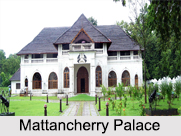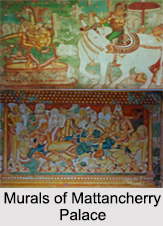 The Mattancherry Palace, popularly known as the Dutch Palace, is situated in the Mattancherry region at Kochi city in the state of Kerala. It is a Portuguese palace which features interesting artefacts and also serves as the portrait gallery of the Cochin Rajas and is famed for housing some of the most beautiful mythological murals of India. These have also gained a position amongst the best traditions of Hindu temple art. The Mattancherry Palace is an architectural marvel exhibiting an amalgamation of Kerala and colonial architectural styles. Mattancherry Palace was declared as centrally protected monument after its restoration in 1951. Its second phase of restoration was carried out by the Archaeological Survey of India with the aim of re-establishing its original grandeur and rendering it an international stature.
The Mattancherry Palace, popularly known as the Dutch Palace, is situated in the Mattancherry region at Kochi city in the state of Kerala. It is a Portuguese palace which features interesting artefacts and also serves as the portrait gallery of the Cochin Rajas and is famed for housing some of the most beautiful mythological murals of India. These have also gained a position amongst the best traditions of Hindu temple art. The Mattancherry Palace is an architectural marvel exhibiting an amalgamation of Kerala and colonial architectural styles. Mattancherry Palace was declared as centrally protected monument after its restoration in 1951. Its second phase of restoration was carried out by the Archaeological Survey of India with the aim of re-establishing its original grandeur and rendering it an international stature.
History of Mattancherry Palace
Mattancherry Palace was a gift to the Raja of Cochin by the Portuguese who built it in 1555. It was gifted in order to appease the king after the Portuguese had plundered a nearby temple. In the year 1663, the palace underwent renovations and extensions by the Dutch and acquired the name Dutch Palace. More improvements were introduced in the fort by other rulers too. In 1498 the Portuguese explorer Vasco da Gama landed at Kappad whom the Kochi rulers had welcomed heartily. Afterwards the Portuguese gained exclusive rights for constructing factories in the region. They also helped greatly to defend the repeated attacks of Zamorins on the Cochin Rajas and the latter became the vassals of Portuguese. However in 1663 the Portuguese influence was replaced by the Dutch who over took the possession of Mattancherry. Subsequently the palace was conquered by Hyder Ali followed by its capture by the British East India Company.
 Structure of Mattancherry Palace
Structure of Mattancherry Palace
Mattancherry Palace exhibits a quadrangular structure constructed in Nalukettu style which is identified as the traditional Kerala style of architecture. At the centre of the palace there is a courtyard where a small temple stands. It is dedicated to the protective Goddess of the Kochi royal family known as Pazhayannur Bhagavati. On either side of the palace, there are two temples where Lord Shiva and Lord Krishna are the presiding deities. European influence can also be witnessed on the palace architecture featured in the proportion of its chambers and the design of its arches. The dining hall of the palace is beautifully adorned with a decorative ceiling carved out of wood and having a series of brass cups. Traditional Kerala flooring can be witnessed in its rarest form in the temple and resembles a polished black marble. Actually the flooring is made of a mixture of lime, burned coconut shells, egg whites, plant juices and charcoal.
Located nearby to the palace is the Paradesi Synagogue which was built in 1568 and in between the Mattancherry Palace and the Synagogue is the Pazhayannur Bhagavathy Temple, who is the ancestral deity or Paradevata of the Cochin Royal Family. The temple with royal patronage which shares its wall with the Jewish synagogue tells volumes about the religious tolerance and inter cultural amity that existed during the time of the Kingdom of Cochin.
Artefacts of Mattancherry Palace
Mattancherry Palace houses a number of artefacts which adds to the glory of the temple. The most significant of these artefacts include the plethora of murals. The murals in the Mattancherry Palace are executed in the best traditions of Hindu temple art, which are religious, decorative and stylised. Vivid colours and rich decorations have earned these murals of Mattancherry Palace a distinct place amongst the traditional arts of India. In the Coronation Hall of the palace, portraits of the rulers of Cochin since 1864 have been showcased. These paintings exhibit western style of art and were painted by the local artists. Other articles displayed in Mattancherry Palace include coins, ceremonial attires worn by the royalty, royal umbrellas, a howdah, an ivory palanquin, drawings and stamps.
Visiting Information on Mattancherry Palace
The nearest railway station is the Cochin station which is at a distance of 6.2 km from the Mattancherry Palace while the Cochin International Airport is at a distance of 42 km from the palace.



















